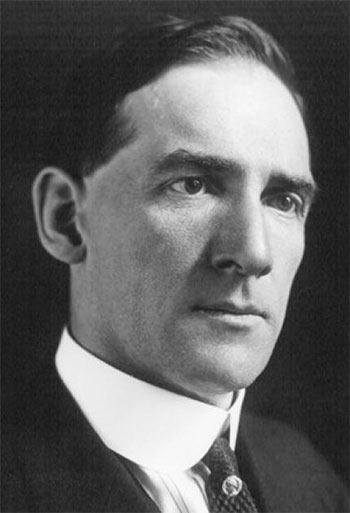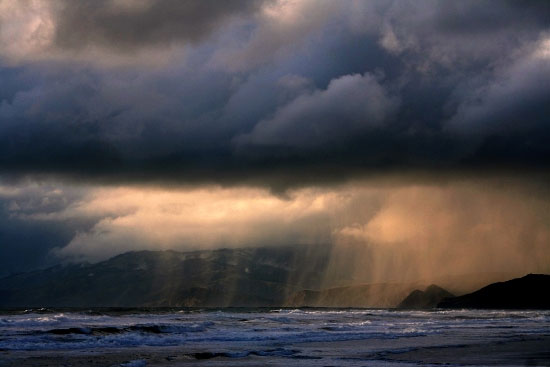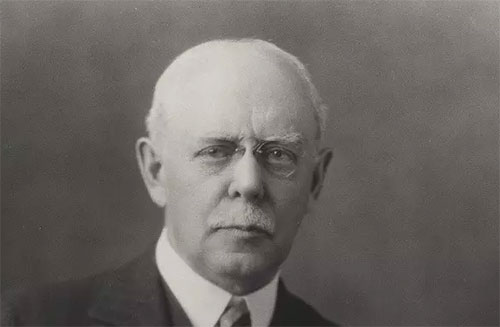Chemtrails Exposed: The Research Corporation for Science Advancement and the Origins of the New Manhattan Project (1)
By Peter A. Kirby
Uncovered evidence indicates that the New Manhattan Project – otherwise known as ‘geoengineering’ – goes back further than previously thought.

As the name ‘New Manhattan Project’ implies, the author was previously under the impression that this ultra-massive, super-secret scientific project (the biggest of all time, in fact) only went back to the mid-1940s; directly after the end of the original Manhattan Project. Your intrepid author has recently found evidence suggesting that the New Manhattan Project should be called the Old Manhattan Project because it now looks like its roots actually go back about 35 years earlier.
The findings presented here have everything to do with an organization called The Research Corporation for Science Advancement and the origins of The Research Corporation for Science Advancement (Research Corporation) have everything to do with the life and work of one Frederick Gardner Cottrell (1877-1948).
The Research Corporation for Science Advancement has a website, a Twitter feed, and a Facebook page.
If you don’t know what the New Manhattan Project is, please refer to the author’s book Chemtrails Exposed: A New Manhattan Project.
Frederick Gardner Cottrell
In the early 1900s Frederick Gardner Cottrell pioneered the field of large-scale, electrostatic removal of coal fly ash from the emissions of coal-fired electrical power plants. This is relevant to the New Manhattan Project for a few reasons.
It is relevant because it has been scientifically proven beyond a reasonable doubt by Dr. Marvin Herndon and his peer-reviewers all over the world that the substance with which we are being routinely sprayed today is coal fly ash. You see, coal fly ash is the smoke that rises from burning coal. It’s a toxic waste by-product of the electrical power industry. There’s a big, cheap supply of it all over the world and if they don’t spray it into our atmosphere, it costs the electrical power companies big money to properly dispose of it. The low cost and ready availability of coal fly ash makes it suitable for geoengineering purposes because geoengineers are talking about spraying tens of thousands of megatons of toxic substances such as this from airplanes ANNUALLY. For more about coal fly ash, please refer to the author’s 2017 article “Chemtrails Exposed: Coal Fly Ash and the New Manhattan Project.”
Not only that, but electrical power companies have a long history in weather modification, and the New Manhattan Project is a global, second generation weather modification project. Specifically, electrical power companies have for many decades openly sprayed silver iodide from ground-based generators in order to make it snow. The runoff from this artificially nucleated snowpack then fills up their mountain reservoirs and is subsequently used to generate hydroelectric power. How much does the Pacific Gas and Electric Corporation love you?
Furthermore, when coal fly ash is electrostatically removed from the exhaust system of a coal-fired power plant, a mini-New Manhattan Project takes place. This is what originally inspired the author’s investigation here. You see, today’s coal fly ash is removed from a power plant’s exhaust system using something called an electrostatic precipitator. These electrostatic precipitators collect fly ash by first electrically charging the airborne ash particles, then attracting them to oppositely charged plates where the ash is then taken away. This is analogous to how, in the course of New Manhattan Project, atmospheric particles are electromagnetically ionized (charged) and then manipulated. This use of electromagnetic energy is the defining aspect of the project and, strangely enough, we see it replicated in this NMP sub-operation of fly ash sequestration. Frederick Cottrell was the American pioneer in the field of electrostatic precipitation.
So, let us learn more about this intriguing Frederick Cottrell character, whose life’s work was so inextricably intertwined with air pollution and, most pertinently, coal fly ash air pollution. Like your author, Cottrell was born in the San Francisco Bay Area. This is his story.
Frederick Gardner Cottrell was born in Oakland, CA in 1877. As a boy, Cottrell marveled at the swift proliferation of applied electrical power. At the age of 19 he received a Bachelors degree in chemistry from the University of California and subsequently became a chemistry teacher at Oakland High School. He then traveled abroad to the Mecca of science, Germany. During this time he also traveled extensively throughout Europe as well as throughout the eastern half of America, visiting just about all of the big scientific universities while meeting and studying under many famous European and American scientists. Upon his return to America, from 1902 to 1911 Cottrell taught physical chemistry at UC Berkeley. Cottrell was gregarious, universally well-liked, and an extraordinarily sharp scientist.

Frederick Gardner Cottrell
In America, Cottrell traveled to many universities which have since been implicated in the production of the New Manhattan Project such as: The University of Chicago, Cornell, Harvard, and the Massachusetts Institute of Technology (MIT).
Most notably, though, on his return journey Cottrell also visited Schenectady, New York; the home of W.R. Whitney’s General Electric Laboratories which was just beginning its long and storied history in the realm of industrial scientific discoveries. In fact, General Electric and Whitney would go on for many years trying unsuccessfully to sign Cottrell as an employee. As readers of this work already know, General Electric appears to be central to the production of the New Manhattan Project.
In 1906 Cottrell first successfully collected and removed unwanted airborne particles with electrical precipitation as part of an industrial process at a DuPont plant engaged in the manufacture of acids and explosives in Pinole, CA. It was not to improve the quality of the breathable air, though. For DuPont, Cottrell found a way to eliminate certain arsenic mists which were a by-product of their industrial processes that were causing production difficulties. Elimination of the arsenic mists during the production of sulphuric acid allowed the DuPont plant to produce their goods much more efficiently. It was during this time that Cottrell drew up his first two successful U.S. patents pertaining to electrical precipitation and a new industry was born.
Once Cottrell had successfully demonstrated his new and improved methods of electrical precipitation, one of Cottrell’s friends, a man by the name of Harry East Miller was sure that Cottrell ‘had something’ and promptly incorporated and became the primary funder of something called the Western Precipitation Company.
The parent corporation of the Western Precipitation Company was something called the International Precipitation Company. The International Precipitation Company held the patents while the Western Precipitation Company was the operating unit. Miller, Cottrell, E.S. Heller, a well-known San Francisco attorney, and Berkeley professor Edmund O’Neill were the original shareholders with seed money investment coming from all except Cottrell. An additional early loan was secured from the Wells Fargo Nevada National Bank.
After returning to Pinole to perfect and definitively demonstrate their improved methods, Western Precipitation’s first real job came in 1907 at the Selby Smelting and Lead Company in Selby, California. This job was all about cleaning up the ambient air.
The troubles at the Selby Smelting and Lead Company were not uncommon. Ever since the Industrial Revolution and all throughout the 19th century, much of the industrialized world (especially Europe and the industrialized centers of America) struggled with poor air quality due to the emissions coming from local factories. At Selby, the downwind residents of Solano County were reporting foul odors, reduced agricultural production, corroded metals, and other significant environmental problems due to the pollution coming from the Selby plant. It got so bad that the residents of Solano County had banded together back in 1905 to petition for an injunction against the Selby plant’s offending emissions.
When officials at the Selby plant heard about Western Precipitation’s successful demonstration of their improved methods at nearby Pinole, they immediately looked to Western Precipitation for a solution to their problems. Western Precipitation’s efforts at Selby were ultimately successful, the air quality in Solano County was restored, and the Selby Smelting and Lead Company continued operations there. It was a win win.
In the years following the successes at Pinole and Selby, Western Precipitation solved emissions problems at industrial facilities such as large copper smelters and cement factories.
In July of 1910, at the first annual meeting of the American Chemical Society in San Francisco, Cottrell held his first major public discussion of his work in the field of electrical precipitation and his speech was well received both domestically and abroad. A variety of air pollution-producing industries as well as civic organizations gave inquiries. Cottrell’s International Precipitation Company was well on its way to prosperity.

In 1911 Cottrell resigned from his position at the University of California at Berkeley and took a job as a physical chemist with the U.S. Bureau of Mines. He took the job because the then director of the Bureau, a man by the name of Joseph A. Holmes, was cultivating an expanded role for the newly created Bureau. One of Holmes’ initiatives was that of organizing efforts related to ameliorating the problem of pollution caused by the burning of coal. Holmes saw air pollution from the burning of coal as an issue for the Bureau of Mines because coal is a mined substance and the organizations burning said coal had intimate business relationships with the miners. Cottrell’s experience in electrical precipitation made him a natural fit.
The Research Corporation for Science Advancement
It was not long after his arrival in Washington, D.C. for his job with the Bureau of Mines in June of 1911, when Cottrell started taking steps towards forming the Research Corporation, as it was originally called. With help from Holmes, the Director of the Bureau of Mines, as part of this process, Cottrell began negotiations with the Smithsonian Institution to let them take over ownership of his patents pertaining to electrical precipitation. It was suggested that the Smithsonian Institution could use funding from the royalties generated by the business development of International Precipitation Company’s patents to fund scientific efforts which had the potential to improve Americans’ daily quality of life.
You see, unlike Bill Gates, George Soros, or so many others, Cottrell was a real philanthropist. He actually wanted to use his patents to foster development of the greater good. He may have been naïve, but his intentions were good.
Cottrell soon returned to the San Francisco Bay Area where he went about organizing a Bureau of Mines office and laboratory in San Francisco. Also at this time, he and his business associates (Miller, Heller, and O’Neill), as a preliminary step to handing their patents over to the Smithsonian, signed over both the Western Precipitation Company and the International Precipitation Company (without patents) to one of Cottrell’s former pupils named Walter A. Schmidt, who became the manager of both the International Precipitation Company and the Western Precipitation Company.
By this time, there was huge interest and activity associated with the Cottrell group’s new technologies and the job offers were coming in from all over the world. With the signing over of the companies, Cottrell and his associates received only modest compensation. With the disposition of his businesses, Cottrell plunged into his work at the Bureau.
In December of 1911, the Regents of the Smithsonian decided to accept Cottrell and associates’ offer with a caveat. The Regents of the Smithsonian advised that a stock corporation be organized which was to take title of the patents. The Regents advised that the Smithsonian Institution be directly represented in this new corporation by the Secretary of the Smithsonian Institution – at the time, a man by the name of Charles D. Walcott (1850-1927). From this arrangement and from the royalties generated by the International Precipitation Company patents, the Smithsonian Institution, they suggested, would stand to benefit financially. This suggested corporation would later be formed as the Research Corporation.
At the time of the Smithsonian’s decision, Cottrell happened to be back east again in Washington D.C. attending an important meeting. Being that the Smithsonian’s Executive Committee was ready to act, Cottrell extended his stay.
After attending the executive session of the Smithsonian’s Board of Regents where they announced their decision pertaining to Cottrell’s patents, Walcott (Secretary of the Smithsonian) and Cottrell adjourned to a restaurant across the street where they ran into Arthur Dehon Little (1863-1935). The presence of Arthur D. Little is important to our discussion because his eponymous corporation (a research organization, no less) was later to do lots of serious work in the vein of the New Manhattan Project.
From little acorns mighty oaks grow. Little was a staunch supporter of Cottrell’s efforts to establish this new corporation – he even suggested the name Research Corporation. Little offered lots of other advice and volunteered to steer Cottrell towards the ‘right’ people. It was Little who put Cottrell in touch with T. Coleman DuPont (1863-1930) who enthusiastically took a seat on the nascent Research Corporation’s board of directors. Little took a seat on the first board as well. Du Pont stayed on the Research Corporation board of directors from 1912 to 1930 while Arthur D. Little remained as a Research Corporation board member from 1912 to 1921.

The newly christened Research Corporation needed more members of the board to oversee their important work. For upwards of two months following the Smithsonian’s decision, Cottrell and Bureau of Mines chief Holmes communicated with about one hundred men from many different vocations in order to find directors for the new Research Corporation. They eventually decided upon 14 well-known men from academia, government, and industry, including a man named Elihu Thompson (1853-1937) who was the founder of something called the Thompson-Houston Company. The Thompson-Houston Company was one of the precursors of the General Electric Company which has only the most serious implications for the New Manhattan Project.
Thomson was also the president of the Massachusetts Institute of Technology from 1920 to 1923. Another original board member was one Charles A. Stone (1867-1941) who was a trustee of the Massachusetts Institute of Technology. This is significant because the Massachusetts Institute of Technology is another organization highly implicated in the science history of the New Manhattan Project. Smithsonian Secretary Walcott took a seat on the Research Corporation board as well. By early February of 1912, the Research Corporation’s original board of directors had been chosen and its Articles of Incorporation were ready to be filed.
Although years later the Research Corporation bought back all of its stock, members of its original board initially paid for founder’s stock which filled the nascent Research Corporation’s coffers and gave the corporation its seed money needed for starting operations.
Over the years, many other luminaries of the New Manhattan Project have served on the Research Corporation’s board of directors including: Karl T. Compton (1887-1954), James R. Killian Jr. (1904-1988), Alfred Lee Loomis (1887-1975), and Vannevar Bush (1890-1974). All four of these men have strong implications for the New Manhattan Project with Loomis and Bush possessing only the strongest. Alfred Lee Loomis was a Research Corporation board member from 1930 to 1933, then again from 1948 to 1959. In 1938 the Research Corporation awarded a grant to Vannevar Bush. Vannevar Bush was a Research Corporation board member from 1939 to 1946.
On February 16 of 1912 the Research Corporation was incorporated under the laws of the state of New York, a one-room office was leased at 63 Wall St., and a manager by the name of Linn Bradley was hired. Cottrell returned to his office work for the Bureau of Mines in San Francisco. A prospectus was printed up and, in order to increase revenue, Bradley went about finding new contract opportunities.
Back in the San Francisco Bay Area once again, Cottrell applied the principals of electrical precipitation to weather modification. This is significant because, as noted earlier, the topic of our study, the New Manhattan Project is, largely and in its essence, a global weather modification project. Specifically, Cottrell experimented with the electrical dissipation of low-lying fogs. Here Cottrell was following in the footsteps of Sir Oliver Lodge (1878-1955) who had successfully performed similar experiments in London many years earlier. This type of weather modification activity, utilizing a charged wire to cause the coalescence of fog, is duly noted in the historical weather modification literature.
Cottrell and his wife moved to Washington D.C. in November of 1916, where they then lived for the next 28 years.
The International Precipitation Company and its subsidiary the Western Precipitation Company flourished under Walter Schmidt’s management. Immediately following the end of hostilities in Europe, Schmidt returned to rejuvenate International Precipitation’s business there. In the course of doing so, he joined forces with Sir Oliver Lodge’s Fume Deposit Company to form the British firm Lodge Cottrell Ltd. To this day Lodge Cottrell Ltd produces and services industrial electrostatic precipitators, mostly outside of America.
In the first two years of its existence, the Research Corporation got its revenue almost entirely from the fees associated with their engineering consultancy work pertaining to the design, installation, and maintenance of electrostatic precipitators. In the first few years of its existence, the Research Corporation mostly went about building up cash reserves.
During this time there were large precipitators being built around the country. By January 1915, about three years after its creation, the Research Corporation had $65K in cash and $100K in secured notes, subsequently, the previously issued founders’ stock was bought back in that same year.
Read the second part of the article
yogaesoteric
May 20, 2020
